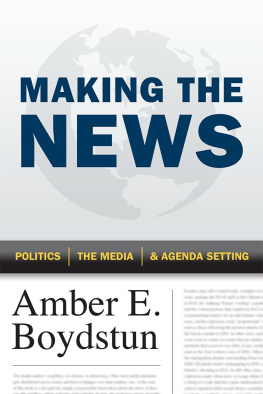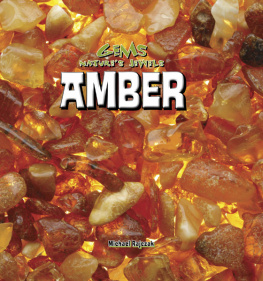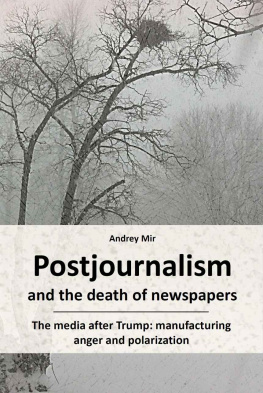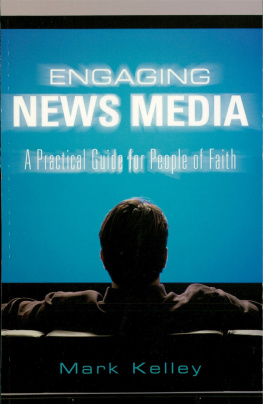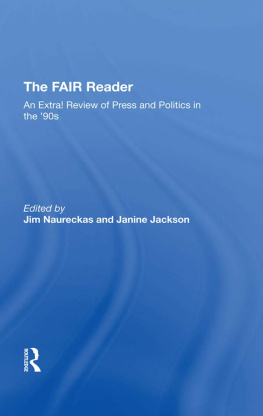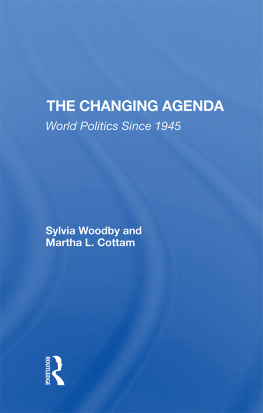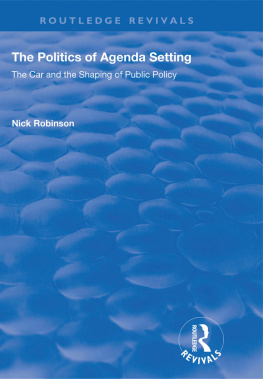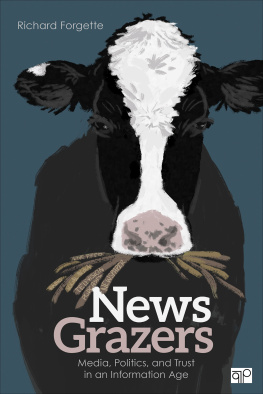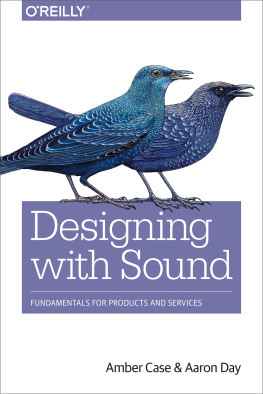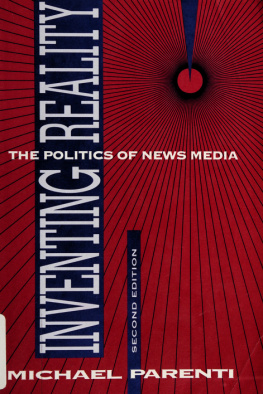Amber Boydstun is assistant professor of political science at the University of California, Davis, and coauthor of The Decline of the Death Penalty and the Discovery of Innocence.
The University of Chicago Press, Chicago 60637
The University of Chicago Press, Ltd., London
2013 by The University of Chicago
All rights reserved. Published 2013.
Printed in the United States of America
22 21 20 19 18 17 16 15 14 13 1 2 3 4 5
ISBN-13: 978-0-226-06543-4 (cloth)
ISBN-13: 978-0-226-06557-1 (paper)
ISBN-13: 978-0-226-06560-1 (e-book)
DOI: 10.7208/chicago/9780226065601.001.0001
Library of Congress Cataloging-in-Publication Data
Boydstun, Amber E., 1977
Making the news : politics, the media, and agenda setting / Amber E. Boydstun.
pages. cm.
Includes bibliographical references and index.
ISBN 978-0-226-06543-4 (cloth : alk. paper) ISBN 978-0-226-06557-1 (pbk. : alk. paper) ISBN 978-0-226-06560-1 (e-book) 1. Press and politicsUnited States. 2. JournalismUnited States. I. Title.
PN4888.P6B66 2013
071.3dc23
2013005897

This paper meets the requirements of ANSI/NISO Z39.48-1992 (Permanence of Paper).
Acknowledgments
Before political science, I did a brief stint in theater. The two crafts are different in so many ways, but they share similarities, too. Both are methodical and precise. Both hinge on the ability to draw clear meaning from complexity. Both have interesting characters.
For me, the parallel to theater is sharpest when thinking about political science as an individual craft and, simultaneously, as a deeply collective endeavor. I have found that writing a book alone is very much like being alone on stage (thrilling, and a little terrifying). Yet I would not, could not, have completed this project without the many people who supported me along the way. That this book exists is due to them. That it is not better is all on me.
We so rarely have the chance to give formal thanks to those colleagues and friends who guide us and lift us up, and so I beg the readers indulgence as I cherish the opportunity. I love the solitary aspects of political science as a craft but, truly, it is the solidarity I have found in this profession that chimes my bells. The names listed so briefly below represent countless gestures (and hours) of assistance, advice, and encouragement.
At the University of Chicago Press, John Tryneski is an editor of impeccable talent and grace. He shepherded me through the submission, acceptance, and publication processes, taking great time and care to make sure I was comfortable every step of the way. When I told him that I wanted to make substantial and time-consuming improvements to the book beyond those that the reviewers had suggested, he did not hesitate before working with me to develop a feasible time line. Also at Chicago, Rodney Powell was a master of coordination. Mark Reschke and, especially, Therese Boyd made the copyediting process seamless. Melinda Kennedy handled the books marketing with finesse. And before any of these fine people handled the book, the UC Davis College of Letters and Science provided publication assistance funds so that Leah Ewing Ross could wield her exceptional editing skills (her friendship, also exceptional, came without charge).
Many research assistants helped make this book a labor of love. The New York Times front-page dataset presented in this book was made possible by a generous grant from the National Science Foundation (No. SES-0617492) and by support from the Department of Political Science and the College of the Liberal Arts at the Pennsylvania State University. The dataset was painstakingly collected by a talented group of students at Penn State while I was a graduate student there. These students attacked the data collection effort with extraordinary attention to detail, and each deserves tremendous thanks: Arman Arvedisian, Amanda Blunt, Kaylan Dorsch, Michelle Falvey, Sarah Gosky, Jamie Guillory, Amanda Kalamar, Alysia Patterson, Kim Roth, Taylor Souter, Gabriel Uriarte, and Matt Vodzak. I am particularly indebted to Scott Huffard, who started as an undergraduate coder, quickly advanced to master coder, and then spearheaded the process of cleaning the entire database once complete; now nearing his own PhD, Scott remains a trusted research assistant on several of my projects. Tim Misiaks computer science genius introduced me to the world of automated text retrieval and analysis that, in turn, redefined the parameters of the book. When I arrived at UC Davis, Jake Delbridge tracked down evasive references. Clare Callahan investigated media explosion anecdotes. Debra Leiter valiantly updated my analysis syntax files. And I am especially grateful to Tim Jurka, whose research assistance has been instrumental in the completion of this book. Among many other magic tricks, Tim built new automated text tools to process the massive dataset of newspaper, television, and online news presented in , which I had originally designed, if you can believe it, in Excel.
In writing this book I benefited from the guidance and kindness of many colleagues, and the book is vastly richer for their thoughtful and helpful comments. At UC Davis, Erik Engstrom, Ben Highton, and Bob Huckfeldt generously offered their time and advice on the project. In one of many acts of true friendship, Ethan Scheiner discerned my hummable tune when I had gone tone deaf. And after I overhauled the book at one point, Walt Stone (who had already been subjected to an unhealthy dose of my work in rough draft form) showed the patience of Job in listening to me pitch my new tune. John Scott provided counsel and encouragement way beyond the call of duty. Outside UC Davis, several additional colleagues gave selflessly of their time by reading part or all of the book and then providing invaluable feedback; my sincere thanks to Matt Baum, Lance Bennett, Daniel Diermeier, Michael Delli Carpini, Jamie Druckman, Justin Grimmer, Shanto Iyengar, and John Wilkerson (as well as very helpful anonymous reviewers). Eric Plutzer was the one to suggest that I should make sure my simulation findings held up using real-world seasonal data. I was able to do so thanks to Vladeta Ajdacic-Gross (Ajdacic-Gross et al. 2005), who shared data on suicides in Switzerland, and Frank Baumgartner, who shared data on French driving. The aforementioned dataset of newspaper, television, and online news is one I collected in conjunction with Frank Baumgartner, Mel Atkinson, Tim Jurka, John Lovett, Jon Moody, and Trey Thomas; my many thanks to Frank for funding that enterprise and to each of these colleagues for allowing me to use the data here. Marie Hojnacki pushed me, very helpfully and always kindly, to make the book more concrete. Suzie Linn is a phenomenal mentor and friend with an uncanny talent for seeing my research conundrums in new and more helpful lights; she was pivotal in the books development and offered continued thoughts and support as it evolved. I am especially grateful to Regina Lawrence, who read the entire manuscript (twice) and offered feedback that was as encouraging as it was constructive, directing me to see not just the theoretical but also the important practical implications of my findings; I cannot thank her enough for her gracious mentorship.
The book also benefited from the insightful questions and comments I received on the project from audiences at Aarhus University; American University; Louisiana State University; Sciences Po, Bordeaux; Suffolk University; West Virginia University; and the universities of Amsterdam, Antwerp, Barcelona, California Merced, Michigan, Nebraska, Washington, and Zurich. Each of these visits was thoroughly enjoyable and helped me refine my theoretical and methodological arguments.
 This paper meets the requirements of ANSI/NISO Z39.48-1992 (Permanence of Paper).
This paper meets the requirements of ANSI/NISO Z39.48-1992 (Permanence of Paper).
